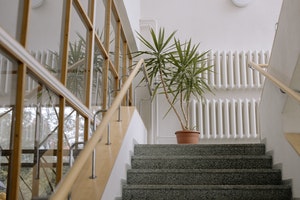Like millions of people all over the world, you've probably been striving for a more organized life...
14 Practical Tips To Stay Safe on the Stairs
Falls, with their potential to cause traumatic injuries, are a serious concern that can have devastating consequences. Among the various hazards that pose a risk to older adults, stairs stand out as particularly treacherous. In fact, a study conducted in the United States has revealed alarming statistics: on average, one million emergency room visits annually are attributed to accidents that occur on staircases, resulting in approximately 12,000 deaths each year.
Considering the potential dangers associated with stairs, it becomes crucial for individuals with elderly loved ones residing in houses equipped with staircases to take proactive measures to ensure their safety. By implementing preventive measures and adopting helpful strategies, it is possible to significantly reduce the risk of trips or falls on stairs, enabling older adults to maintain their independence and live safely. In the following sections, we will delve into a range of practical tips designed to make stairs safer for older adults, helping you to create a secure environment for your loved one.
14 Tips to Stay Safe on the Steps!
-
Alter Open Tread Stairs
Open-tread stairs are particularly hazardous as they trick the eye and can cause confusion, particularly for those living with dementia. It may not be practical or convenient to completely replace a staircase, but simply boxing in open-tread stairs can make a great difference in improving safety.
-
Remove Carpet Runners
To make a stairway safer, replace old and worn stair carpeting and runners with non-slip flooring. More importantly, to avoid issues down the line, be sure to have it installed by a qualified builder. Not only should carpets be properly stretched to prevent sagging and bunching up, but they should also be tightly stretched against the nosing of each step.
-
Improve Lighting
 Dark staircases are an accident waiting to happen, particularly for an older person with worsening eyesight. Hire an electrician to install light switches at the top and bottom of the stairs, and encourage your loved one to switch them on and off as needed. Click here to learn more about home safety lighting tips!
Dark staircases are an accident waiting to happen, particularly for an older person with worsening eyesight. Hire an electrician to install light switches at the top and bottom of the stairs, and encourage your loved one to switch them on and off as needed. Click here to learn more about home safety lighting tips! -
Wear Appropriate Footwear
If your loved one experiences any mobility problems, the correct footwear can be helpful, providing excellent grip and support for the feet. Old or worn shoes and slippers should be thrown out and replaced with sturdy and practical footwear with a non-slip sole.
-
Keep the Path Clear
Stairs should offer a clear path and be free of clutter. Many people of all ages use the first few stairs as a place to hold items that need to go upstairs eventually. However, these extra piles of laundry or pieces of clutter can be a trip hazard. Instead, keep a basket near the stairs to store those items and have someone else take them up at another time.
-
Choose Paint Colors Wisely
For many seniors with compromised vision, it can be hard to tell where one step ends and another step begins. To mitigate the danger, consider painting the stairs in contrasting colors. Alternating between light and dark colors makes each stair more visible, ensuring a safe passage for your loved ones. Or, add bright-colored tape to the end of each step. However, it's important to ensure the tape does not come undone and present another tripping hazard.
-
Add Handrails
 Stairways in the home should have railings on both sides. Most staircases have a handrail on one side. Still, for older adults who may be unsteady on their feet, having handrails on both sides of the staircase provides valuable additional support. Make sure handrails are sturdy and fit the hand comfortably.
Stairways in the home should have railings on both sides. Most staircases have a handrail on one side. Still, for older adults who may be unsteady on their feet, having handrails on both sides of the staircase provides valuable additional support. Make sure handrails are sturdy and fit the hand comfortably.The rails should be firmly secured to the wall at elbow height to provide maximum support. Be sure to test that the rails can hold an adult's full body weight without becoming detached from the wall or post. If possible, arrange for the handrail to continue beyond the length of the staircase.
-
Adjust the Rise
In some cases, a complete remodel of the staircase can be the best option. If possible, choose stairs that have a lower rise so that you or your loved one doesn't have to step as high to get to the next stair.
-
Remove Hazards
Rugs should never be placed close to a staircase as they increase the risk of tripping and falling. Check stairs and steps for any potential dangers, such as items of furniture nearby that could cause your loved one to trip or stumble. Ideally, the route to a staircase should be clear, well-lit, and uncluttered.
-
Add Non-Slip Strips
While carpet runners are a tripping hazard, hardwood stairs also make slipping a possibility. To make hardwood stairs safer for seniors, add non-slip strips to the steps.
-
Reduce Stair Time
Consider adapting the home's design to reduce the number of times one needs to go up the stairs. For example, a main-level bedroom and bathroom can cut down on the need to go upstairs as often. The fewer trips up the stairs, the lower the risk of falling on them.
-
Get a Stairlift
Getting a stairlift is the safest method for seniors to get up and down the stairs. Electric stairlifts are extremely easy to use and can carry you or your family up and down the stairs without the hassle. Some models on the market can fit not only linear but also curved or spiral staircases.
-
Include a Resting Spot
If you have a larger home with a wide staircase, consider adding a comfortable bench on a landing. This can give seniors a helpful break on the way up or down the stairs.
-
Improve Balance and Build Strength
This safety measure is related to personal improvement rather than home improvement. Exercises that reduce fall risk while navigating the stairs will focus on basic leg-strengthening exercises. A beneficial exercise routine should include calf raises, mini-lunges, single-leg lifts, and mini-squats.
Consider these tips to ensure you and your loved ones are safe on a daily basis! Let us know in the comments below - How do you ensure your steps are safe?





.jpg?width=600&name=iStock-1393065538%20(1).jpg)

